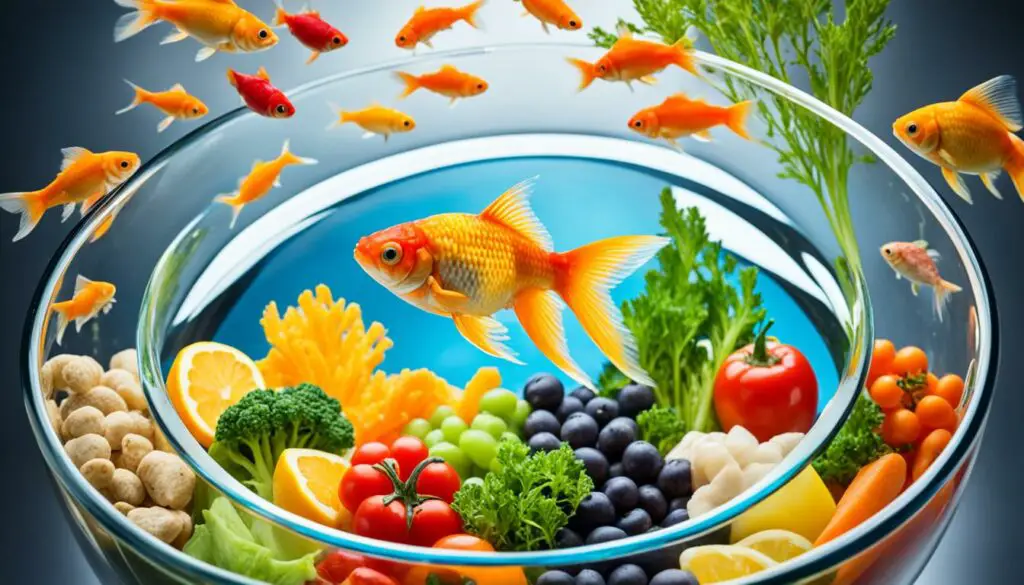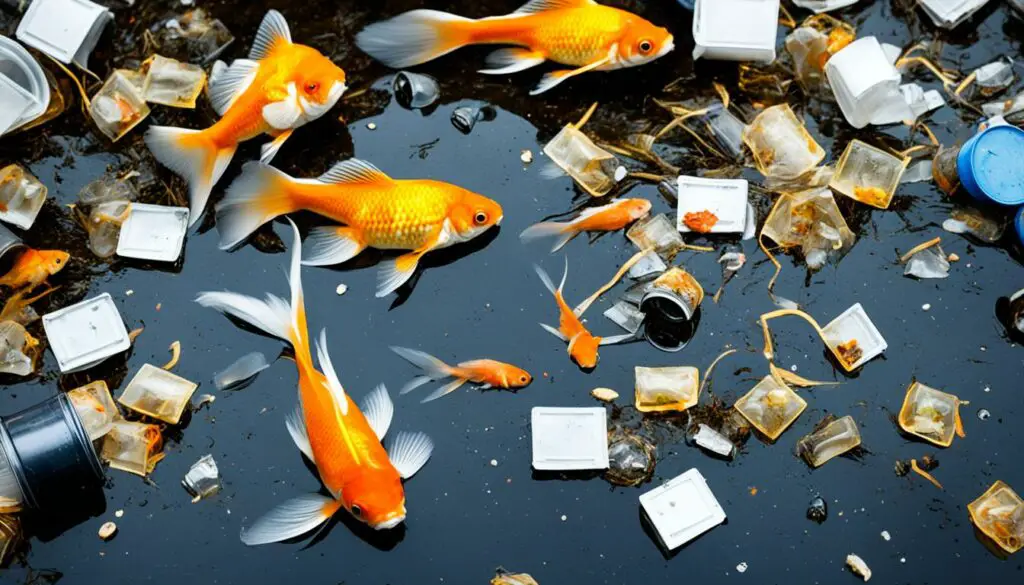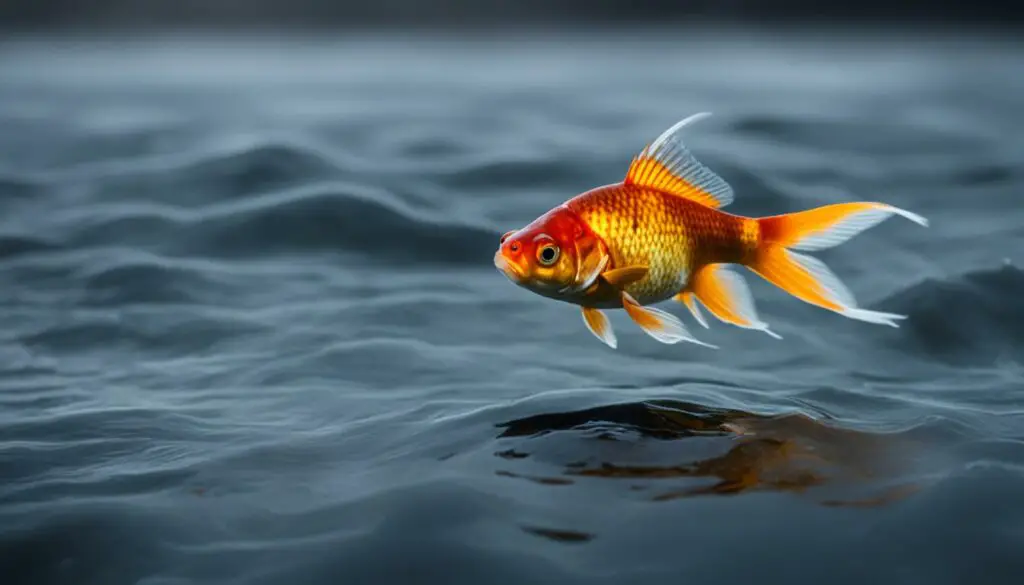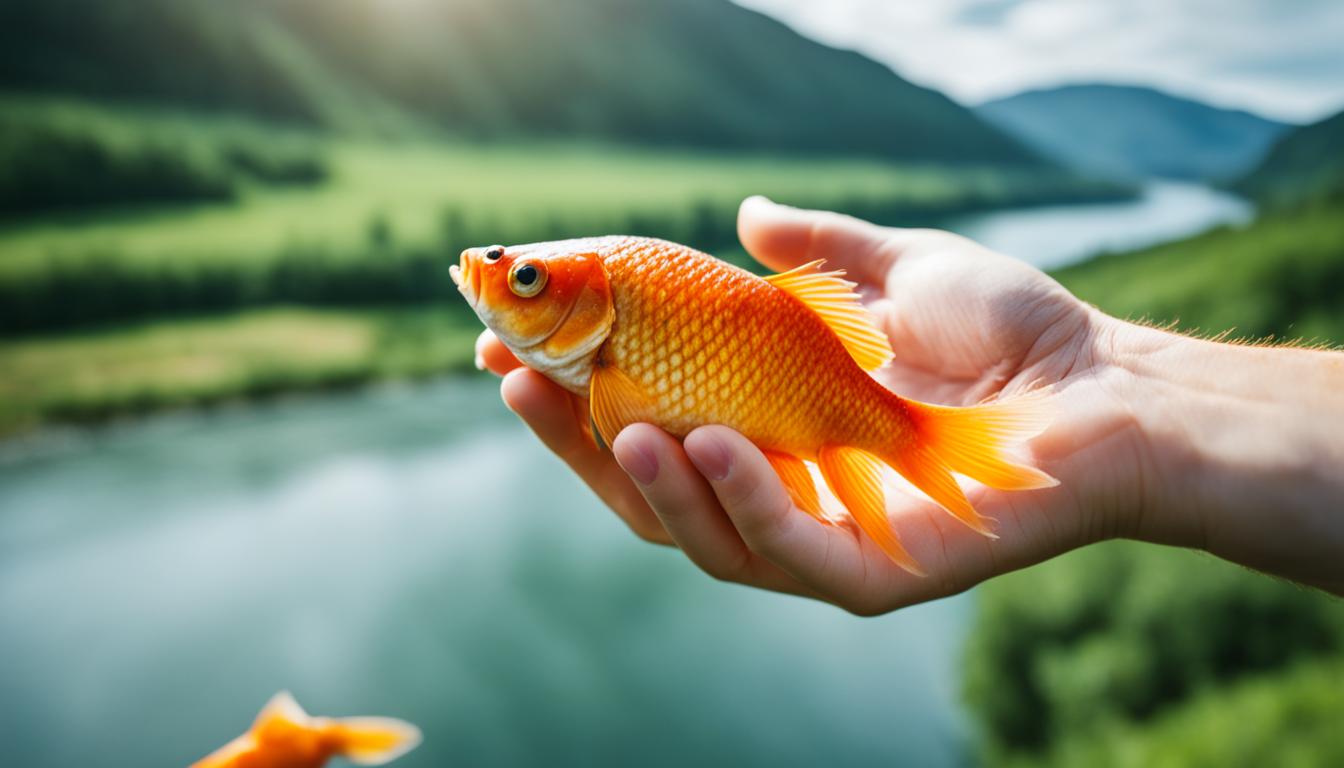Last Updated on 2 weeks by admin
Are you curious about whether you can eat wild goldfish? Perhaps you’ve caught some while fishing and wondered if they are safe for consumption. In this article, we will explore the topic of eating wild goldfish and provide you with the information you need to make an informed decision.
Key Takeaways:
- Eating wild goldfish is technically possible but not recommended
- Goldfish have a strong, foul taste and an abundance of bones
- Goldfish may carry bacteria and diseases that can be harmful to humans
- There are better, more appetizing options for seafood consumption
- Goldfish should be appreciated as pets rather than food
Goldfish as Food: Exploring the Edible Prospects
While goldfish are typically known as popular pets, they are also considered edible. As a relative of carp, goldfish share a lineage with a fish that has been used as food for many years. However, there are several factors to consider when it comes to consuming goldfish.
One of the main challenges with eating goldfish is their small size and abundance of bones, making them difficult to debone and prepare. Cooking options for wild goldfish can be limited due to their size, which may result in an uneven cooking process and an undesirable eating experience.
Goldfish cooking options for wild goldfish:
- Baking
- Grilling
- Frying
The taste of goldfish can be fishy and muddy if they are not prepared well. Their environment and diet can greatly influence their flavor, and if not properly addressed, it can lead to an unappetizing culinary experience.
While some cultures have incorporated goldfish into their cuisine, it is generally not recommended to eat goldfish due to their texture, taste, and potential health risks. Goldfish contain a high amount of bones, which can be unpleasant to consume and pose a choking hazard.
Additionally, goldfish may carry bacteria and parasites that can be harmful when ingested. It is important to ensure that goldfish intended for consumption are sourced from safe and controlled environments. Consumption of wild goldfish may expose individuals to various health risks due to potential exposure to pollutants, medications, and diseases present in their natural habitats.
| Pros of Consuming Goldfish | Cons of Consuming Goldfish |
|---|---|
| – Goldfish are a relative of carp, which has been a food source for many years. | – Goldfish are small and bony, making them difficult to debone and prepare. |
| – Some cultures have incorporated goldfish into their cuisine. | – The taste of goldfish can be fishy and muddy. |
| – Goldfish are a potential source of protein and omega-3 fatty acids. | – Goldfish may carry bacteria and parasites, posing health risks. |
The Nutritional Benefits of Goldfish

Goldfish, like other freshwater fish, can provide nutritional benefits. They are a good source of protein and omega-3 fatty acids. However, the small size and bony nature of goldfish may make it difficult to derive a substantial amount of nutrients from them. There are better options for obtaining these nutrients, such as other types of fish that are more commonly consumed.
Protein Content Comparison
| Goldfish (100g) | Salmon (100g) | |
|---|---|---|
| Protein | 14g | 22g |
While goldfish do contain protein, the comparison with salmon, a popular fish known for its high protein content, shows that goldfish are not the most efficient source of protein. Salmon provides a significantly higher amount of protein per 100 grams compared to goldfish.
Omega-3 Fatty Acids
Omega-3 fatty acids are essential for the body and are often associated with cardiovascular health and brain function. While goldfish do contain omega-3 fatty acids, the amount is relatively low compared to other fish varieties, such as salmon, sardines, and tuna. These fish are known for their rich omega-3 fatty acid content and are commonly consumed for their health benefits.
Alternative Fish for Nutritional Benefits
- Salmon
- Sardines
- Tuna
- Mackerel
It is recommended to focus on consuming fish varieties that are known for their higher nutritional value, such as salmon, sardines, tuna, and mackerel. These fish provide a greater amount of protein and omega-3 fatty acids, ensuring a more substantial nutritional benefit compared to goldfish.
While goldfish can contribute to a balanced diet, it is more advisable to opt for other fish species that offer a higher nutritional value. Incorporating a variety of fish into your meals can provide a broader range of nutrients and ensure optimal health benefits.
The History and Cultural Significance of Carp as Food

Carp, the relative of goldfish, has a long and rich history of being used as food in various cultures around the world. In fact, carp has been an important culinary ingredient for centuries, particularly in China, Hungary, the Czech Republic, and Jewish cuisine.
In China, carp has been a staple food for thousands of years. It is believed to have been domesticated as early as the Tang Dynasty (618-907), and since then, it has been bred and enjoyed for its unique taste and texture. Carp is often served during festive occasions, symbolizing abundance, prosperity, and good luck.
Hungary is also known for its deep-rooted tradition of carp consumption. Every year, during the Christmas season, Hungarian families gather around the dining table to enjoy a special dish called “Fisherman’s Soup,” which is traditionally made with carp. The dish is considered a symbol of the holiday spirit and is deeply cherished within Hungarian culture.
In the Czech Republic, carp holds a special place in the culinary repertoire. It is a popular choice for Christmas Eve dinner, where families traditionally prepare the fish in various ways, such as roasted, fried, or served in a fish soup. The carp’s delicate flavor and firm flesh make it a beloved ingredient in Czech cuisine.
Furthermore, carp plays a significant role in Jewish cuisine, especially during the holiday of Passover. Carp gefilte fish, a traditional dish made from ground carp, is a staple on the Seder table. The dish symbolizes the Jews’ liberation from slavery in ancient Egypt and the hope for a sweet and prosperous year ahead.
“Carp has been an irreplaceable part of our culinary heritage for generations,” says Chef David Goldstein, a renowned expert in Jewish cuisine. “Its distinct taste and versatility make it a beloved ingredient in many traditional dishes.”
When it comes to the taste and culinary usage of carp, it is important to note that the fish’s habitat can significantly influence its flavor. Carp caught in cleaner environments tend to have a cleaner, sweeter taste, resembling that of salmon. As an oily fish, carp offers a rich and succulent flavor profile, which becomes even more pronounced when prepared using traditional cooking techniques and spices.
Carp in Different Culinary Traditions
| Culture | Traditional Carp Dish |
|---|---|
| China | Steamed Whole Carp |
| Hungary | Fisherman’s Soup |
| Czech Republic | Carp Fried in Butter |
| Jewish | Carp Gefilte Fish |
Why Eating Goldfish Is Discouraged

Eating goldfish is generally discouraged for several reasons. Firstly, goldfish have a distinctive taste that mirrors their diet, which includes processed fish flakes or pellets. As a result, consuming goldfish may not be appetizing due to the unpalatable flavors they acquire. Moreover, goldfish are small and bony, making it challenging to extract a substantial amount of meat from them.
There are also health concerns associated with eating goldfish. Goldfish, particularly those caught in the wild, can carry bacteria such as Fish Tuberculosis, which can be transmitted to humans. This poses a risk to anyone consuming goldfish as a food source.
From an ethical standpoint, goldfish are commonly kept as pets and are not intended to be consumed. These beautiful aquatic creatures are highly valued by their owners, who provide them with a safe and nurturing environment. It is important to respect their role as beloved pets rather than considering them as a food source.
Therefore, due to taste, health risks, and ethical considerations, it is not recommended to eat goldfish.
Goldfish have become highly popular as pets and are valued for their beauty and unique characteristics. They bring joy and companionship to many households, making them unsuitable for consumption.
Reasons Not to Eat Goldfish:
- Distinctive taste mirrors their diet, often resulting in unpleasant flavors
- Small and bony structure makes them difficult to eat
- Potential health risks associated with bacteria they may carry
- Ethical concerns as goldfish are commonly kept as pets
While some cultures may have incorporated goldfish into their cuisine, it is important to consider the negative aspects and the overall consensus regarding their consumption. It is clear that goldfish are better appreciated for their beauty and companionship as pets rather than as a source of food.
| Reasons Not to Eat Goldfish | Description |
|---|---|
| Taste | Goldfish acquire flavors from their diet, which can result in unappetizing tastes. |
| Structure | Goldfish have a small and bony structure, making it difficult to extract a substantial amount of meat. |
| Health Risks | Goldfish, especially those caught in the wild, can carry bacteria that may pose health risks to humans. |
| Ethical Concerns | As commonly kept pets, goldfish should be respected and cared for rather than consumed. |
The Dangers of Eating Wild Goldfish

While some people might consider eating wild goldfish as a way to manage their populations, there are several health risks associated with consuming them. Wild goldfish may have been exposed to pollutants and medications, which can still be present in their bodies. Additionally, the taste and texture of wild goldfish may not be palatable due to their diet and environment. It is not recommended to eat wild goldfish, even if they are caught in fishing activities.
Eating wild goldfish can pose potential health risks due to the following reasons:
- Exposure to pollutants and medications: Wild goldfish often reside in bodies of water that may be contaminated with pollutants such as heavy metals or chemicals. These substances can accumulate within the fish’s flesh, posing a risk to human health if consumed.
- Unpalatable taste and texture: Wild goldfish typically feed on a variety of natural food sources, which can affect their taste and texture. Their diet can consist of algae, insects, and other aquatic organisms, resulting in a distinct flavor and texture that may be unappealing to many individuals.
- Lack of quality control: Unlike commercially produced fish, wild goldfish lack quality control measures in terms of hygiene and safety standards. There are no regulations in place to ensure the health and safety of wild goldfish as food.
- Potential presence of parasites and diseases: Wild goldfish are susceptible to various parasites and diseases that can be harmful to humans. Consuming these fish without proper cooking or processing methods can lead to the transmission of these parasites and diseases.
Considering these health risks, it is strongly advised to avoid eating wild goldfish. Instead, individuals seeking fish as a food source should opt for commercially available options that have undergone proper quality assurance and meet health and safety standards.
Why Animals Shouldn’t Eat Goldfish Either
While goldfish may seem like a tempting snack for certain animals, it is important to understand why it is not advisable to let them indulge in these petite fish. Although some animals, such as cats, possess the ability to consume goldfish, it does not mean that it is a healthy or suitable dietary choice for them.
Goldfish may not provide the necessary nutritional value that other animals require for their overall well-being. An animal’s diet should consist of a balanced mix of proteins, carbohydrates, fats, vitamins, and minerals, which may not be adequately provided by goldfish. There are numerous alternative food options available that are specifically formulated to meet the dietary needs of various animals. It is crucial to prioritize their health by providing them with a proper diet.
In addition to the lack of nutritional benefits, there are potential risks associated with animals consuming goldfish. These small fish can carry bacteria and diseases that can be harmful not only to other pets but also to wildlife. By allowing animals to eat goldfish, we risk spreading these harmful agents and compromising the health of our beloved companions and the environment they inhabit.
To protect goldfish from being consumed by other animals and to ensure the well-being of all creatures involved, it is essential to create a suitable environment for the goldfish to live as pets. This entails keeping them in secure tanks or ponds that are specifically designed for their needs. By providing them with the care and attention they deserve, we can appreciate the beauty of goldfish without risking their health or the well-being of other animals.
“Animals should be respected and cared for, not seen as a source of food for other animals.”
The Cultural Significance of Goldfish as Pets
Goldfish have a long history of being kept as pets, especially in East Asia. They are seen as symbols of luck and prosperity and are often kept in ornamental ponds. The cultural importance of goldfish as pets has contributed to their popularity as aquarium fish around the world. Rather than being consumed, goldfish should be cherished and cared for as pets, as they bring beauty and joy to their owners.
Symbol of Luck and Prosperity
Goldfish hold significant cultural meaning in various East Asian countries, symbolizing luck and prosperity. In Chinese culture, goldfish are believed to bring wealth, fortune, and good luck to households. Their bright colors and graceful movements are associated with positive energy and harmony.
Ornamental Ponds and Aquariums
The tradition of keeping goldfish in ornamental ponds dates back centuries. These ponds often feature elaborate designs and are considered a form of art. In addition to ponds, goldfish are popular choices for aquariums due to their vibrant colors and peaceful demeanor. They are known for their resilience and adaptability, making them suitable pets for both beginners and experienced fish keepers.
“Goldfish are more than just pets; they represent beauty, tranquility, and a connection to nature.” – Fishkeeping Magazine
The Therapeutic Effect of Goldfish
Goldfish can have a soothing and calming effect on individuals, making them popular as therapy pets. Observing their serene swimming patterns and vibrant colors can help reduce stress and anxiety. Many hospitals, nursing homes, and rehabilitation centers incorporate goldfish as part of their therapy programs to promote emotional well-being and relaxation.
Education and Conservation
Goldfish also play a role in education and conservation efforts. Their popularity as pets allows researchers and educators to study their behavior and biology, promoting a better understanding of aquatic environments. Conservation organizations leverage the cultural significance of goldfish to raise awareness about freshwater ecosystems and the importance of protecting aquatic life.
Cultural Significance of Goldfish as Pets
| Country | Significance |
|---|---|
| China | Symbol of wealth and fortune |
| Japan | Representative of good luck and prosperity |
| Thailand | Considered sacred and believed to bring blessings |
| Vietnam | Associated with good fortune and harmony |
The Future of Goldfish Consumption
While some fisheries have started harvesting goldfish for commercial purposes, the overall attitudes towards consuming goldfish are unlikely to change significantly. The taste, texture, and ethical concerns surrounding goldfish consumption make them an unpopular choice for food. It is more likely that goldfish will continue to be appreciated as pets and as part of cultural traditions, rather than being viewed as a viable food source.
Consumer Attitudes Towards Consuming Goldfish
Consumers have shown a strong aversion towards the idea of eating goldfish. The taste of goldfish, often described as fishy and muddy, is unappealing to many palates. Furthermore, the small size and abundance of tiny bones make them difficult and time-consuming to prepare. As a result, most individuals prefer to enjoy goldfish as pets rather than on their plates.
Moreover, ethical concerns play a significant role in shaping consumer attitudes towards goldfish consumption. Goldfish are commonly kept as pets due to their beauty and companionship. They are cherished members of households and are not seen as suitable candidates for culinary purposes.
“I could never bring myself to eat a goldfish. They are such fascinating creatures and make wonderful pets. It just feels wrong to consume them.”
– Rachel, a goldfish enthusiast
The Role of Goldfish in Cultural Traditions
Goldfish have long held cultural significance in many parts of the world, particularly in East Asia. They are revered as symbols of luck and prosperity and are often kept in ornamental ponds or displayed during festivals and celebrations. This cultural attachment has contributed to the widespread appreciation of goldfish as pets and their role in traditional practices.
| Culture | Significance of Goldfish |
|---|---|
| China | A symbol of wealth, abundance, and good fortune |
| Japan | Representative of perseverance and strength |
| India | Believed to bring blessings and ward off negative energy |
Given the cultural and symbolic value attached to goldfish, it is unlikely that they will lose their status as cherished pets and be consumed as a common food source in the future.
Overall, the future of goldfish consumption remains rooted in their role as beloved pets and cultural icons, rather than as a widely accepted food choice. With their mesmerizing beauty and unique characteristics, goldfish will continue to swim their way into our hearts and homes.
Conclusion
In conclusion, while goldfish are technically edible, it is not recommended to eat them due to their taste, texture, and potential health risks. Goldfish are small, bony fish with a strong, fishy taste that may not be appealing to most people. Additionally, goldfish may carry bacteria and diseases that can be harmful to humans and other animals. It is more suitable to appreciate goldfish as pets and to enjoy their beauty and companionship.
FAQ
Is it safe to eat wild goldfish?
While goldfish are technically edible, it is not recommended to eat them, especially if they are caught in the wild. Goldfish may carry bacteria and diseases that can be harmful to humans.
Are goldfish considered edible?
Goldfish are considered edible since they are related to carp, which has been used as food in various cultures. However, the small size and abundance of bones in goldfish make them difficult to prepare and eat.
Is it healthy to eat goldfish?
Goldfish can provide nutritional benefits such as protein and omega-3 fatty acids. However, their small size and bony nature make it challenging to derive a substantial amount of nutrients from them. There are better options for obtaining these nutrients from other types of fish.
What is the history and cultural significance of carp as food?
Carp has a long history of culinary usage in various cultures, including China, Hungary, the Czech Republic, and Jewish cuisine. Carp is often consumed for its flavor, which can resemble that of salmon when prepared correctly.
Why is eating goldfish discouraged?
There are several reasons why eating goldfish is discouraged. Goldfish have strong, fishy taste and muddy texture, which can be unappealing. They also carry a risk of transmitting bacteria and diseases, and ethically, they are commonly kept as pets rather than being consumed.
What are the health risks of eating wild goldfish?
Wild goldfish may have been exposed to pollutants and medications, which can still be present in their bodies. Additionally, the taste and texture of wild goldfish may not be palatable due to their diet and environment. It is not recommended to eat wild goldfish, even if they are caught in fishing activities.
Can animals eat goldfish?
While some animals might have the ability to eat goldfish, it is not advisable to let them do so. Goldfish may not provide the necessary nutrients for other animals, and there are healthier and safer food options available. Goldfish can also carry bacteria and diseases that can be harmful to other pets and wildlife.
What is the cultural significance of goldfish as pets?
Goldfish have a long history of being kept as pets, especially in East Asia. They are seen as symbols of luck and prosperity and are often kept in ornamental ponds. Goldfish bring beauty and joy to their owners and are appreciated as pets rather than being consumed.
What is the future of goldfish consumption?
While some fisheries have started harvesting goldfish for commercial purposes, the overall attitude towards consuming goldfish is unlikely to change significantly. Goldfish will continue to be valued as pets and as part of cultural traditions, rather than being viewed as a viable food source.
Can you eat goldfish?
While goldfish are technically edible, it is not recommended to eat them due to their taste, texture, and potential health risks. Goldfish are small, bony fish with a strong, fishy taste that may not be appealing to most people. It is more suitable to appreciate goldfish as pets and to enjoy their beauty and companionship.
Source Links
- https://www.foodrepublic.com/1294337/can-you-eat-a-goldfish/
- https://thegoldfishtank.com/goldfish-info/facts/eating-goldfish/
- https://aquariumstoredepot.com/blogs/news/can-you-eat-goldfish


